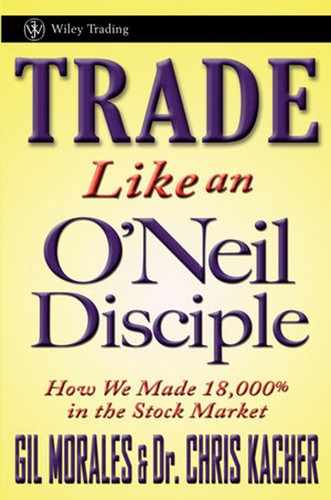3.5. PATIENCE AND A WATCHFUL EYE
Because Oracle had originally broken out in early September 1999, well before the market had bottomed and turned to the upside again in late October, it was too early to buy the stock on that first breakout, and so it ended up backing and filling for another six weeks as it formed another consolidation or base on top of the prior handle from which it broke out in early September. I considered this lack of upside thrust as confirmation of my earlier assessment that the stock just wasn't showing the kind of earnings acceleration that I considered optimal at the time. Nevertheless, I kept the stock on my watch list as it built this second six-week base on top of the prior handle consolidation, essentially forming a very powerful base-on-base formation.
A base-on-base formation is often a powerful formation because it is visually showing you a stock that has broken out and really wants to move higher, but because the general market environment is not ready yet, for instance, is not in an up-trending bull phase, the stock simply goes about its business setting up in another consolidation or base just above the prior breakout point, as you can see in Figure 3.9, as it "coils" in anticipation of springing higher once the weight of the general market lifts. Oracle also flashed a volume clue in this second base as it pulled back sharply right after breaking out of the first base in early September. As I've labeled on the chart, you can see that this sharp pullback was very much like a little shakeout that saw volume pick up sharply as the stock bounced right off the top of the prior base and closed that day in the upper part of its daily trading range, a clear sign of support on the pullback. This was a critical clue that institutions used that pullback as a clear opportunity to accumulate Oracle stock in size. Oracle then spent the next six weeks for the most part moving sideways, even attempting to make one early breakout through the $12 price level that resulted in the stock backing down again and retesting its 50-day moving average. There was nothing wrong with Oracle stock on this initial breakout attempt that failed—it was simply that the market was not ready. This illustrates a strong concept of Livermore's that one must wait for the "line of least resistance" to be penetrated, and in Oracle's case it meant that not only did the stock itself need to be set up properly but also that Oracle had to be "cleared for takeoff" by the general market environment.
Figure 3.9. Oracle Corporation's (ORCL) breakout from cup-with-handle base pauses to build a six-week base to complete what ultimately becomes a base-on-base formation as it waits for the general market to turn bullish.: Chart courtesy of eSignal, Copyright 2010

